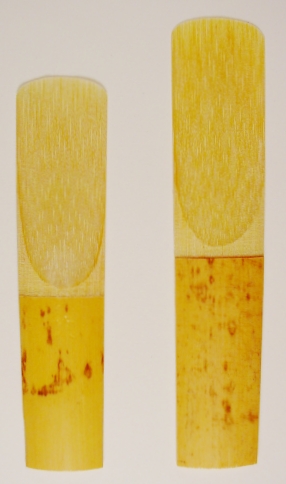Reed (mouthpiece) facts for kids
A reed is a small, thin piece of material that vibrates to make sound on a musical instrument. Think of it like a tiny flap that wiggles very fast! Most reeds for woodwind instruments are made from a type of tall grass called Arundo donax, also known as "Giant cane." Some are also made from plastic or other man-made materials.
Instruments like harmonicas and accordions use reeds made of metal or special plastics. These reeds are "tuned," meaning they are made to produce specific musical notes. Different musical instruments are grouped by the kind and number of reeds they use.
Contents
Single Reeds
What are Single Reeds?
Clarinets and saxophones use single reeds. These reeds are flat on one side, which sits against the instrument's mouthpiece. The other side is rounded and gets thinner towards the tip. The tip is curved to match the mouthpiece.
Single reeds are mostly rectangular, but their thin, vibrating tip is curved. While they all look similar, their sizes change to fit different instrument mouthpieces.
Reed Strength
Even if reeds for the same instrument look alike, they can feel different when you play them. This is because they vary in thickness, also called "hardness" or "strength." Reed strength is usually measured on a scale from 1 (softest) to 5 (hardest). However, this scale isn't the same for all brands, so a "strength 3" reed from one company might feel different from a "strength 3" from another.
The thickness of the reed's tip and base, along with its overall shape, affects how it sounds and how easy it is to play. Even cane from different plants, cut the same way, can feel different because natural cane fibers vary in density.
How Single Reeds are Made
The special cane used for reeds grows in sunny, coastal areas like southern France, Spain, and parts of Argentina. After the cane is cut, workers lay it in the sun for about a month to dry completely. They turn it often so it dries evenly.
Once dry, the cane is stored. When it's time to make reeds, the cane goes to a factory. There, machines cut it into tubes and sort these tubes by their size and how thick their walls are. Then, the tubes are cut into smaller pieces called "splits," which are then shaped into reed "blanks."
Finally, these blanks are shaped and thinned into finished reeds using special blades or computer-controlled machines. Another machine then checks each completed reed and sorts them by their strength.
Double Reeds
What are Double Reeds?
Double reeds are used on instruments like the oboe, English horn, bassoon, and contrabassoon. Unlike single reeds, double reeds usually don't use a mouthpiece. Instead, two pieces of reed vibrate against each other to make sound.
Some instruments, like the crumhorn or bagpipes, have a special cap over the double reeds. The player blows into this cap, and the reeds vibrate inside without touching the player's mouth. Like single reeds, double reeds are also graded from hard to soft based on their strength.
How Double Reeds are Made
Making double reeds starts much like making single reeds. The cane is harvested from Arundo donax, dried, and cut into smaller, easier-to-handle pieces. The cane is sorted by its diameter, with common sizes for oboe reeds being around 9.5 to 11 millimeters. Some musicians prefer different sizes depending on the time of year or weather.
Next, the cane tubes are split into three equal parts. Any warped pieces are thrown out because they won't vibrate correctly. The good pieces are then "gouged" in a machine. This process removes many layers of cane, making the pieces much thinner. This makes it easier for the reed-maker to scrape the reed later and helps keep their knives sharp. Reed makers become very skilled at sharpening their tools!
Finally, the gouged cane pieces are soaked in water and shaped using razor blades. They are then left to dry. After drying, they are soaked again. For oboe reeds, the shaped cane is tied onto a small metal tube called a "staple." For bassoon reeds, it's formed on a tool called a "mandrel." Bassoon reeds are wrapped with nylon or cotton thread, while oboe reeds usually use nylon.
The last step involves the reed-maker carefully scraping the cane with a special knife. They scrape until the reed has specific measurements and lengths, depending on the style and the musician's preference. A double reed is finished when it plays in tune or makes a good "crow" sound, which is a specific buzzing noise.
Quadruple Reeds
What are Quadruple Reeds?
Quadruple reed instruments have four reeds: two on top and two on the bottom. A famous example is the Shehnai from India. Other instruments like the Pi from Thailand and the Cambodian Sralai also use four reeds. Having four reeds instead of two creates a very different sound and a unique set of musical tones called harmonics.
Free Reeds
Types of Free Reeds
There are two main kinds of free reeds: framed and unframed.
- Framed free reeds are found in ancient Asian instruments like the Chinese shēng and Japanese shō. They are also in modern European instruments such as the harmonium, harmonica, and accordion. In these, the reed is made of cane, willow, brass, or steel and is held inside a stiff frame. The pitch (how high or low the note is) of a framed free reed is fixed.
- Unframed free reeds are more basic. The ancient bullroarer is an unframed free reed. It's a stone or wood board tied to a rope that you swing through the air to make a whistling sound. Another simple unframed free-reed instrument is a leaf, used in some traditional Chinese music. A leaf or long blade of grass is stretched between your thumbs. You can change the pitch by bending your thumbs slightly to adjust the tension. Cupping your hands can also change the sound.
Materials for Reeds
Most reeds for woodwind instruments are made from cane. However, some clarinet, saxophone, and double reed players, as well as bagpipers, use synthetic (man-made) reeds.
Synthetic reeds usually last longer and don't need to be wet before playing. But many musicians feel that synthetic reeds don't produce as good a sound quality as cane reeds.
Newer synthetic reeds, made from special synthetic polymer compounds, are becoming more popular as their technology improves. Synthetic reeds are especially useful if you play an instrument on and off, with long breaks, because natural cane reeds can dry out quickly.
The dizi, a Chinese transverse flute, uses a unique reed called a di mo. This reed is made from a paper-like bamboo membrane.
Commercial vs. Handmade Reeds
In the past, musicians made their own reeds from cane using simple tools. This took a lot of time and effort. Today, special tools help cut and trim reeds by hand, making the process faster.
Most players of single-reed instruments buy reeds that are made in factories. However, many still adjust these reeds by carefully scraping or sanding them. Some professional musicians even make their own single reeds from scratch, but this is very time-consuming and can require expensive equipment.
For double reed players, advanced and professional musicians usually make their own reeds. Beginners and students often buy reeds from their teachers or from stores.
Care and Maintenance
Reeds made from cane, used on instruments like saxophones, clarinets, oboes, and bassoons, are very sensitive to changes in temperature and humidity. A reed might play differently in a cold practice room compared to a warm stage. While these changes are normal, musicians learn to adjust.
Manufacturers make reeds in different strengths, usually marked with numbers like 2, 2.5, 3, 3.5, 4, 4.5, and 5. A machine checks the stiffness of the reed to determine its strength. A box of "strength 3" reeds might actually contain reeds that vary slightly, for example, from 2.75 to 3.25. Often, not every reed in a box is perfect or "playable."
If a reed is too soft, you can sometimes keep it hoping it will get a bit stiffer over time. If a reed is too stiff, there are ways to adjust it. One simple method is to gently rub the reed on a clean piece of paper, making sure to apply even pressure. This can help if the reed is only slightly too stiff or if its tip isn't perfectly flat. For reeds that are more than a little too stiff, fine sandpaper (around 300–500 grit) can be used carefully to remove a tiny bit of material. Always be very careful not to damage the delicate tip of the reed.
Sometimes a reed doesn't play well because of a small mistake during its manufacturing. While not always fixable, a special tool called a "reed pen" can sometimes help reshape or realign the reed. Reed pens can be expensive.
To make your reed last longer, soak it in water for about two minutes, or until it's fully moist but not waterlogged. When you first get a new reed, play it for about five minutes on the first day, 15 minutes on the second, and 45 minutes on the third. After this, continue to soak it before playing, and you can play it for as long as you need.
"Reed Players"
In musical groups, especially in musical theatre orchestras, woodwind players are often called "reed players" or simply "reeds." These musicians don't just play one woodwind instrument; they often play several different ones. Even though flutes are not reed instruments, flute players are usually included in this group.
A typical pit orchestra (the orchestra for a musical) might have only four or five reed players who play all the woodwind instruments (flute, oboe, clarinet, bassoon, saxophone). A basic "reed part" in a musical might require a player to switch between three or four instruments, with flutes, clarinets, and saxophones being the most common. However, some parts can be much more demanding, requiring a player to use up to eight different instruments! For example, the "Reed 3" part in Bernstein's West Side Story asks the player to use piccolo, flute, oboe, English horn, clarinet, bass clarinet, and both tenor and baritone saxophones. By having players switch instruments, the arranger can make the woodwind section sound much larger than it actually is.
See also
 In Spanish: Lengüeta para niños
In Spanish: Lengüeta para niños




